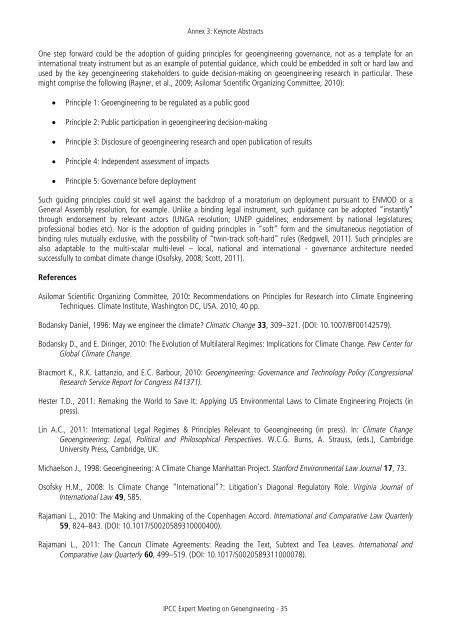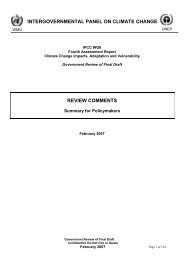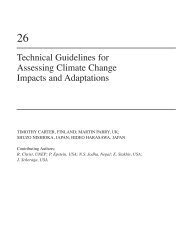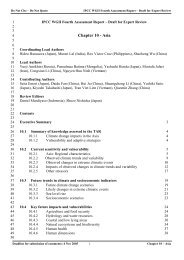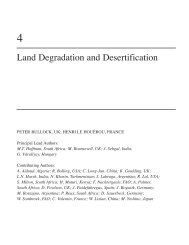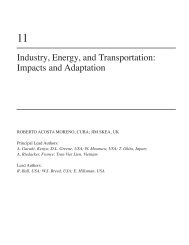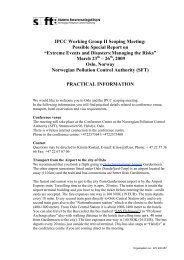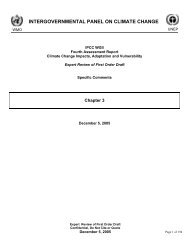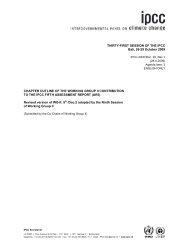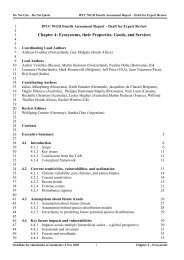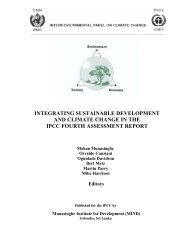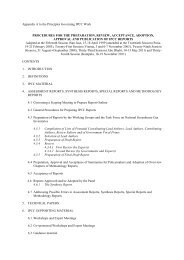IPCC Expert Meeting on Geoengineering
IPCC Expert Meeting on Geoengineering
IPCC Expert Meeting on Geoengineering
You also want an ePaper? Increase the reach of your titles
YUMPU automatically turns print PDFs into web optimized ePapers that Google loves.
Annex 3: Keynote Abstracts<br />
One step forward could be the adopti<strong>on</strong> of guiding principles for geoengineering governance, not as a template for an<br />
internati<strong>on</strong>al treaty instrument but as an example of potential guidance, which could be embedded in soft or hard law and<br />
used by the key geoengineering stakeholders to guide decisi<strong>on</strong>-making <strong>on</strong> geoengineering research in particular. These<br />
might comprise the following (Rayner, et al., 2009; Asilomar Scientific Organizing Committee, 2010):<br />
<br />
<br />
<br />
<br />
<br />
Principle 1: <strong>Geoengineering</strong> to be regulated as a public good<br />
Principle 2: Public participati<strong>on</strong> in geoengineering decisi<strong>on</strong>-making<br />
Principle 3: Disclosure of geoengineering research and open publicati<strong>on</strong> of results<br />
Principle 4: Independent assessment of impacts<br />
Principle 5: Governance before deployment<br />
Such guiding principles could sit well against the backdrop of a moratorium <strong>on</strong> deployment pursuant to ENMOD or a<br />
General Assembly resoluti<strong>on</strong>, for example. Unlike a binding legal instrument, such guidance can be adopted “instantly”<br />
through endorsement by relevant actors (UNGA resoluti<strong>on</strong>; UNEP guidelines; endorsement by nati<strong>on</strong>al legislatures;<br />
professi<strong>on</strong>al bodies etc). Nor is the adopti<strong>on</strong> of guiding principles in “soft” form and the simultaneous negotiati<strong>on</strong> of<br />
binding rules mutually exclusive, with the possibility of “twin-track soft-hard” rules (Redgwell, 2011). Such principles are<br />
also adaptable to the multi-scalar multi-level – local, nati<strong>on</strong>al and internati<strong>on</strong>al - governance architecture needed<br />
successfully to combat climate change (Osofsky, 2008; Scott, 2011).<br />
References<br />
Asilomar Scientific Organizing Committee, 2010: Recommendati<strong>on</strong>s <strong>on</strong> Principles for Research into Climate Engineering<br />
Techniques. Climate Institute, Washingt<strong>on</strong> DC, USA. 2010, 40 pp.<br />
Bodansky Daniel, 1996: May we engineer the climate? Climatic Change 33, 309–321. (DOI: 10.1007/BF00142579).<br />
Bodansky D., and E. Diringer, 2010: The Evoluti<strong>on</strong> of Multilateral Regimes: Implicati<strong>on</strong>s for Climate Change. Pew Center for<br />
Global Climate Change.<br />
Bracmort K., R.K. Lattanzio, and E.C. Barbour, 2010: <strong>Geoengineering</strong>: Governance and Technology Policy (C<strong>on</strong>gressi<strong>on</strong>al<br />
Research Service Report for C<strong>on</strong>gress R41371).<br />
Hester T.D., 2011: Remaking the World to Save It: Applying US Envir<strong>on</strong>mental Laws to Climate Engineering Projects (in<br />
press).<br />
Lin A.C., 2011: Internati<strong>on</strong>al Legal Regimes & Principles Relevant to <strong>Geoengineering</strong> (in press). In: Climate Change<br />
<strong>Geoengineering</strong>: Legal, Political and Philosophical Perspectives. W.C.G. Burns, A. Strauss, (eds.), Cambridge<br />
University Press, Cambridge, UK.<br />
Michaels<strong>on</strong> J., 1998: <strong>Geoengineering</strong>: A Climate Change Manhattan Project. Stanford Envir<strong>on</strong>mental Law Journal 17, 73.<br />
Osofsky H.M., 2008: Is Climate Change “Internati<strong>on</strong>al”?: Litigati<strong>on</strong>’s Diag<strong>on</strong>al Regulatory Role. Virginia Journal of<br />
Internati<strong>on</strong>al Law 49, 585.<br />
Rajamani L., 2010: The Making and Unmaking of the Copenhagen Accord. Internati<strong>on</strong>al and Comparative Law Quarterly<br />
59, 824–843. (DOI: 10.1017/S0020589310000400).<br />
Rajamani L., 2011: The Cancun Climate Agreements: Reading the Text, Subtext and Tea Leaves. Internati<strong>on</strong>al and<br />
Comparative Law Quarterly 60, 499–519. (DOI: 10.1017/S0020589311000078).<br />
<str<strong>on</strong>g>IPCC</str<strong>on</strong>g> <str<strong>on</strong>g>Expert</str<strong>on</strong>g> <str<strong>on</strong>g>Meeting</str<strong>on</strong>g> <strong>on</strong> <strong>Geoengineering</strong> - 35


